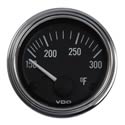Don't know if this is correct but I did a "google search" and got this info from "rv.net"
Here is a quote from the Orange ($8.95) GM manual:
--------------------------------------------------------------------------------------
"OIL TEMPERATURE MEASURED AT CONVERTER OUTLET TO COOLER.
300F is the maximum temperature. (Workhorse says 350F). This is the normal place to install a temperature gauge or signal. The temperature in this location will vary significantly with each vehicle start-up or hill. If the temperature reaches 300F (350F), reduce throttle. To lower the transmission temperature with the transmission in NEUTRAL, run the engine at 1,200 RPM for 2-3 minutes to cool the oil. Do not allow the converter outlet temperature to exceed 300F (350F).
Keep a close check to prevent the engine cooling system from overheating.
300F would be typical of rocking the vehicle in mud, snow, or sand, or a transmission in stall (full throttle, no vehicle movement). When the transmission is in stall, the transmission will develop heat at a rate of one degree per second of stall.
OIL TEMPERATURES MEASURED IN THE SUMP
150F -- Minimum operating temperature for continuous operation. It is possible in low ambient temperature to overcool the transmission with oil to air-type coolers; it is hard to overcool if used in conjunction with oil to water coolers installed in most standard automotive
[COLOR=#0072bc !important][COLOR=#0072bc !important]radiators[/COLOR][/COLOR].
190F-200F -- Maximum oil level checking temperature. Beyond this, readings are not reliable because of expansion.
285F -- Maximum sump/oil pan temperatures for short duration such as a long hill climb.
300F -- Metal parts inside the transmission begin to warp and distort in varying degrees, seals melt rapidly, and transmission fluid life is extremely short due to oxidation and distress.
AUTOMATIC TRANSMISSION FLUID OXIDATION Automatic transmission fluid
can provide up to 100,000 miles of service before oxidation occurs under normal operating temperatures of about 170F. Above normal operating temperatures, the oxidation rate doubles (useful life of the fluid is cut in half) with each 20 degree increase in temperature. The approximate life expectancy at various temperatures is a follows:
Degrees F Miles
175 100,000
195 50,000
212 25,000
235 12,000
255 6,000
275 3,000
295 1,500
315 750
335 325
375 80
390 40
415 Less than 30 minutes
After-market temp gauge should be installed in the lower (hot) line entering the lower fitting of the radiator.
After-market external oil to air cooler should be installed in series. The hot oil line should go first through the aftermarket cooler then into the radiator to maintain proper minimum temp of the trans in low ambient temps.”
End of GM copy from orange manual.
------------------------------------------------------------------
Note: Later (green) manual says run through radiator heat exchanger first. Don't know why they changed.
My take on this: A converter outlet reading should give the first indication of heat increase. It also lets you know if you are near maximum fluid temp of 300 (or 350 in Workhorse manual). Another reason I like converter out temp is it gives you not only info to save your tranny, but it also tells you how much heat your are putting into your radiator, thereby allowing you to perhaps avoid an engine overheat by shutting off dash air or whatever else you do. Having a pan temp reading allows you to be sure you don't exceed max pan temp of 285F for the TH400 and lets you know if your cooler is big enough for the hill you just climbed. Once you have climbed your biggest hill on your hottest day without an overtemp event, you can forget about watching the tranny temp.




